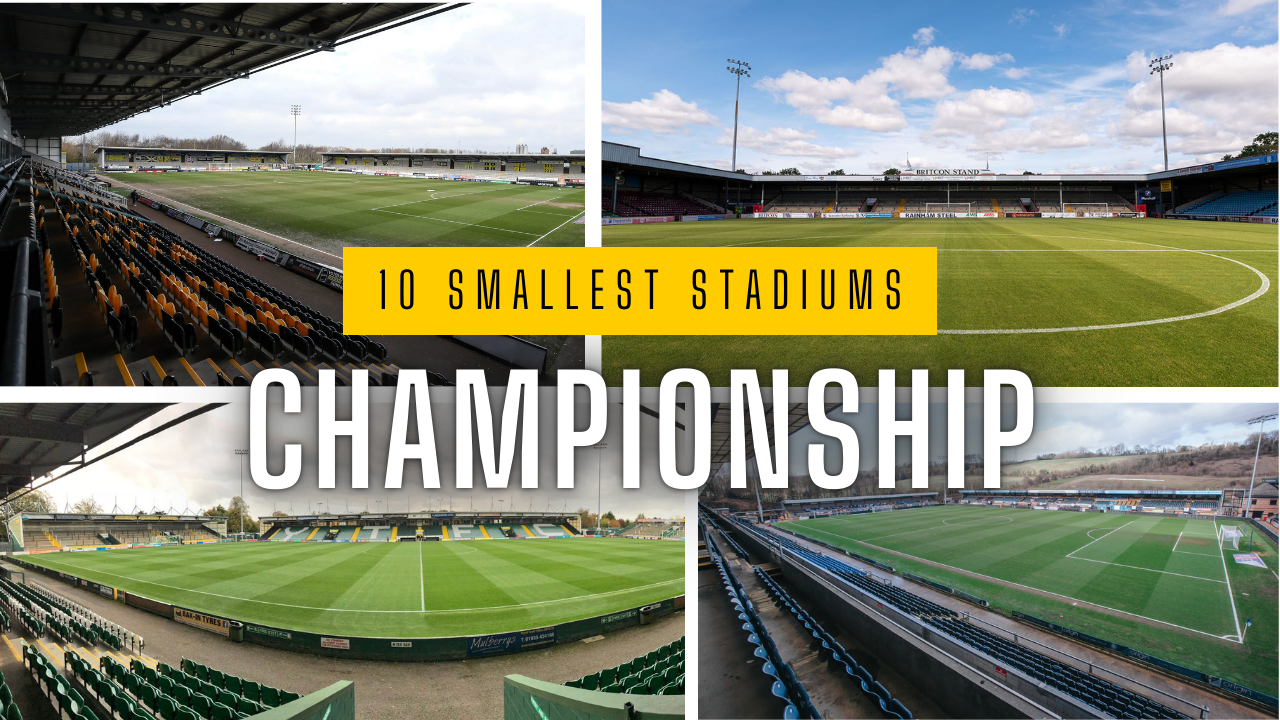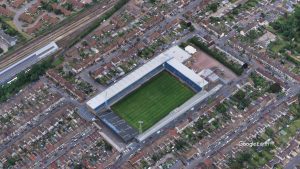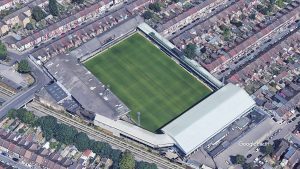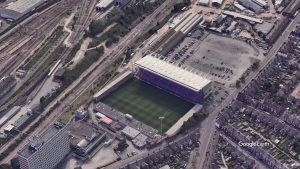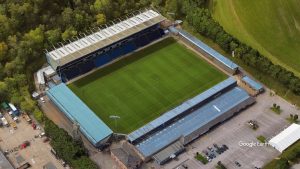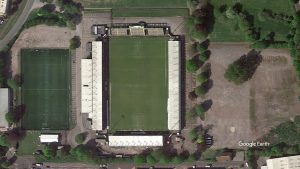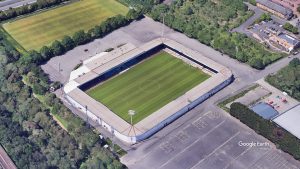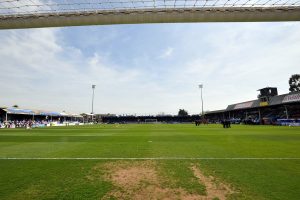Since the inception of the EFL Championship in 2004, England’s second tier has seen a total of 62 different stadiums host league matches. While some clubs have played in massive venues like the Stadium of Light or Hillsborough, others have competed in far more modest surroundings.
In this article, we explore the 10 smallest stadiums to ever host Championship football.
| Stadium | Club | Opened | Closed (if applicable) | Capacity |
| Layer Road | Colchester United | 1910 | 2008 | 6,320 |
| Pirelli Stadium | Burton Albion | 2005 | Still in use | 6,912 |
| Millmoor | Rotherham United | 1907 | 2008 | 8,300 |
| Withdean Stadium | Brighton & Hove Albion | 1936 | 2011 | 8,850 |
| Glanford Park | Scunthorpe United | 1988 | Still in use | 9,088 |
| Huish Park | Yeovil Town | 1990 | Still in use | 9,565 |
| Adams Park | Wycombe Wanderers | 1990 | Still in use | 10,137 |
| Gresty Road (Alexandra Stadium) | Crewe Alexandra | 1906 | Still in use | 10,153 |
| Kenilworth Road | Luton Town | 1905 | Still in use | 10,226 |
| Priestfield Stadium | Gillingham | 1893 | Still in use | 11,582 |
10. Priestfield Stadium – Gillingham FC
The 10th smallest ever stadium in the English Championship with a capacity of approximately 11,500 seats is Priestfield Stadium. It has been the home of Gillingham Football Club since its formation in 1893.
After years in the lower divisions, Gillingham achieved promotion to the second tier (then called Division One) by winning the 2000 Second Division Play-Off Final at Wembley. After five years in the Championship, the club was relegated in 2004-05. Since relegation, Gillingham has fluctuated between League One and League Two.
9. Kenilworth Road – Luton Town
Kenilworth Road is one of the most unique and historic stadiums in English football. Home to Luton Town since 1905, it is famous for its quirky design, tight stands, and the unusual entrance through a row of terraced houses. With a current capacity of just over 10,000, it is the smallest stadium to have ever hosted a Premier League match and the 9th smallest in the history of the Championship.
Luton Town has had a rollercoaster history in the English football. The Hatters enjoyed a golden period in the late 1980s, but by the early 2000s, financial problems saw them plummet through the divisions, eventually dropping to non-league football in 2009. They returned to the Championship in 2019.
8. Gresty Road – Crewe Alexandra
Gresty Road, officially known as the Mornflake Stadium for sponsorship reasons, has been the home of Crewe Alexandra since 1906. Located in the railway town of Crewe, the stadium is one of the smallest to have hosted Championship football, with a capacity of just over 10,000.
Crewe Alexandra is best known for its dedication to youth development, producing talented players who have gone on to play at the highest levels. The club’s golden era came under the legendary Dario Gradi, who managed the team for over 30 years across multiple spells. The club was promoted to the second tier of English football for the first time in 1997. Crewe spent eight of the next nine seasons in that level and was relegated from the Championship in 2006. Since then, the club has bounced between League One and League Two.
7. Adams Park – Wycombe Wanderers
Adams Park has been the home of Wycombe Wanderers since 1990. With a capacity of just over 10,000, it is one of the smallest stadiums to have ever hosted Championship football.
Wycombe Wanderers were traditionally a non-league club for most of their history, before earning a place in the Football League in 1993. For much of the late 1990s and early 2000s, Wycombe established themselves as a solid League One side, famously reaching the FA Cup semi-finals in 2001. The real fairytale moment came in 2020, when Gareth Ainsworth, one of the longest-serving managers in English football, led Wycombe to an unlikely promotion to the Championship for the first time in their history.
6. Huish Park – Yeovil Town
Located in the town of Yeovil, Huish Park has been the home of Yeovil Town Football Club since 1990. The stadium, with a capacity of 9,565, is the 6th smallest ground to have ever hosted Championship football.
For most of their history, Yeovil Town was known as a non-league club with a strong FA Cup pedigree. That changed in 2003, when the club was promoted from the Conference into the Football League for the first time in their history. The most remarkable chapter in Yeovil’s history came in 2012-13, when the club, against all odds, earned promotion to the Championship. The played in that level for only one year.
5. Glanford Park – Scunthorpe United
Glanford Park has been the home of Scunthorpe United since 1988. It holds a unique place in English football history as the first purpose-built all-seater stadium constructed for a Football League club after the Taylor Report. With a capacity of 9,088, it was one of the smallest grounds to have ever hosted Championship football games.
Scunthorpe United, known as The Iron, has traditionally been a lower-league club. In 2006-07, Scunthorpe won League One, finishing as champions and earning promotion to the Championship but were relegated after just one season. Their second stint in the Championship was between 2009 and 2011.
4. Withdean Stadium – Brighton & Hove Albion
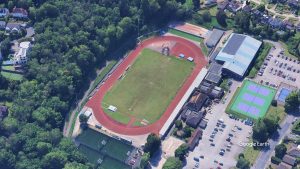
Withdean Stadium was one of the most unusual stadiums ever to host Championship football. Originally an athletics stadium, it became the home of Brighton & Hove Albion in 1999, following the club’s exile from their traditional home at The Goldstone Ground. It originally had a capacity of 2,000 people, which was increased to 8,850 when Brighton played there.
Despite its limitations, Withdean served as Brighton’s home for 12 seasons (1999-2011), during which the club achieved several promotions. After securing two back-to-back promotions they reached the Championship in 2002. The club moved to the new Falmer Stadium in 2011.
3. Millmoor – Rotherham United
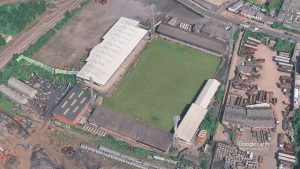
Millmoor was the home of Rotherham United for over 100 years, from 1907 to 2008. With a capacity of 8,300, it was one of the smallest stadiums to ever host Championship football. It remained Rotherham’s home until 2008, when ownership disputes between the club and the stadium’s landlords forced the team to leave. Despite not having a permanent tenant, the stadium still remains intact.
Traditionally a lower-league club, Rotherham rose to the Championship in the 2001-02 season. Since then, Rotherham have gained a reputation as a yo-yo club, frequently bouncing between the Championship and League One.
2. Pirelli Stadium – Burton Albion
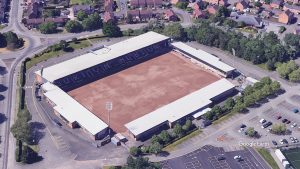
The Pirelli Stadium has been the home of Burton Albion since its opening in 2005. With a capacity of 6,912, it is the second smallest stadium to ever host Championship football.
Burton Albion, nicknamed “The Brewers”, were historically a non-league club, playing in the lower divisions of English football for most of their history. However, in the late 2000s, they began a rapid climb through the leagues. Burton’s biggest achievement came in the 2015-16 season, when after finishing second in League One they reached the Championship for the first time in their history.
1. Layer Road – Colchester United
Layer Road was the home of Colchester United from 1937 until 2008, serving as a classic lower-league English football stadium. It had a final capacity of just 6,320, making it the smallest stadium to ever host Championship football.
Colchester United’s rise to the Championship in 2006 made it clear that the club needed a new, more modern home. In 2008, the club left Layer Road and moved to the Colchester Community Stadium. In mid-2012, Layer Road was eventually demolished.

